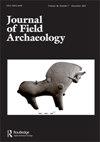In Search of a Borderland: Material Culture Patterns on the Southern Limits of the North American Southwest
IF 1.5
1区 历史学
0 ARCHAEOLOGY
引用次数: 0
Abstract
ABSTRACTRecent research conducted in southern Sonora, Mexico provides an opportunity to revisit debates about interaction between Mesoamerica and the North American Southwest (NAS). In the borderland between these traditions, communities show few signs of cultural amalgamation, instead exhibiting either an avoidance of overt identity markers or an emphasis on more local connections. This pattern contrasts with most discussions of Mesoamerican influence on the NAS that focus on regionally atypical centers of foreign goods consumption or evidence of foreign religious traditions in distant localities. By recentering on local contexts where cultural amalgamation is expected but minimal, we raise important questions about why more distant groups found Mesoamerican societies to be worthy of emulation. The results suggest researchers should devote equal attention to cases in which distinct identities are erased or suppressed as they do to cases in which social boundaries are maintained or created anew.KEYWORDS: Borderlandssocial boundariescultural amalgamationMesoamericaNorth American SouthwestRio SonoraSerrana AcknowledgementsWe extend our profound appreciation to the communities that hosted this research, including Rosario de Tesopaco, Nuri, Quiriego, Sahuaripa, Tacupeto, Onapa, Choix, and Mochicahui. We are further indebted to other regional scholars whose data sharing made this research possible, especially Cristina García-Moreno, Emilliano Gallaga, and the late Richard Pailes.Disclosure StatementThe authors report there are no competing interests to declare.Notes1 From provided figures, three of these appear to be “Santa Ana” described above, which are likely not from the core Casas Grandes region.Additional informationFundingThis work was supported in large part by National Science Foundation Grant BCS 1724445, with supplemental funding by a University of Oklahoma Junior Faculty Fellowship, a Rust Family Foundation Grant, and the Instituto Nacional de Antropología e Historia.Notes on contributorsJohn Philip CarpenterJohn Philip Carpenter (Ph.D. 1996, University of Arizona) is a researcher at the Instituto Nacional de Antropología and Historia, Sonora. His interests include ethnohistory and social organization.Guadalupe SánchezGuadalupe Sanchez Miranda (Ph.D. 2010, University of Arizona) is a researcher at the Instituto Nacional de Antropología and Historia, Sonora who specializes in hunters and gatherers of the Sonoran Desert.Rommel Tapia-CarrascoRommel Tapia-Carrasco is a licenciatura student (Pasante) at the Escuela Nacional de Antropología e Historia affiliated with the Instituto Nacional de Antropología and Historia, with research interests that span from the Mayan region to the Sonoran Desert.Andrew R. KrugAndrew R. Krug (M.A. 2018, University of Missouri) is a Ph.D. student at the University of Oklahoma who focuses on theories of exchange and sourcing methodologies.Edson CupaEdson Cupa is a licenciatura student (Pasante) at the Escuela Nacional de Antropología e Historia, with research interests in Mesoamerica and northwestern Mexico.Dakota LarrickDakota Larrick (M.A. 2021, University of Oklahoma) is a graduate student at the University of Arizona with interests in dendrochronology/climatology and human-environmental interactions.Carlos Eduardo HernándezCarlos Eduardo Hernández is a licenciatura student (Pasante) at the Escuela Nacional de Antropología e Historia, with research interests in Mesoamerica and northwestern Mexico.Robin R. SingletonRobin R. Singleton (B.S. 2015, Hiram College) is a Ph.D. student at the University of Oklahoma with research interests in molecular anthropology and a focus on human/animal interactions.Matthew C. PailesMatthew Pailes (Ph.D. 2015, University of Arizona) is an Associate Professor at the University of Oklahoma. His research interests include resilience theory and agricultural societies. Orcid 0000-0001-9045-5671.寻找边疆:北美西南南部边界的物质文化模式
摘要最近在墨西哥索诺拉南部进行的研究为重新审视中美洲和北美西南部(NAS)之间相互作用的争论提供了机会。在这些传统之间的边界地带,社区几乎没有表现出文化融合的迹象,相反,他们要么避免公开的身份标志,要么强调更多的地方联系。这种模式与大多数关于中美洲对北美地区影响的讨论形成鲜明对比,这些讨论关注的是地区性非典型的外国商品消费中心或遥远地区外国宗教传统的证据。通过重新审视文化融合的地方背景,我们提出了一个重要的问题,为什么更遥远的群体发现中美洲社会值得效仿。研究结果表明,研究人员应该对那些不同的身份被抹去或压制的情况给予同样的关注,就像他们对那些维持或重新建立社会界限的情况一样。关键词:边疆、社会边界、文化融合中美洲、北美、西南、索诺或塞拉那感谢我们对主持这项研究的社区表示深切的感谢,包括Rosario de Tesopaco、Nuri、Quiriego、Sahuaripa、Tacupeto、Onapa、Choix和Mochicahui。我们还要感谢其他地区的学者,他们的数据共享使这项研究成为可能,特别是克里斯蒂娜García-Moreno, Emilliano Gallaga和已故的Richard Pailes。声明作者报告无竞争利益需要申报。注1从提供的数字来看,其中三个似乎是上文所述的“圣安娜”,它们可能不是来自卡萨斯格兰德斯核心地区。这项工作在很大程度上得到了国家科学基金会拨款BCS 1724445的支持,俄克拉荷马大学青年教师奖学金、Rust家庭基金会拨款和国家历史研究所的补充资金。作者简介约翰·菲利普·卡彭特约翰·菲利普·卡彭特(1996年亚利桑那大学博士)是索诺拉国立Antropología和历史研究所的研究员。他的兴趣包括民族史和社会组织。瓜达卢佩SánchezGuadalupe桑切斯·米兰达(2010年亚利桑那大学博士)是索诺拉国家研究所Antropología和历史研究所的一名研究员,专门研究索诺拉沙漠的猎人和采集者。Rommel Tapia-Carrasco是国立Antropología历史学院下属的国立Antropología历史学院的一名学生(Pasante),他的研究兴趣从玛雅地区到索诺拉沙漠。Andrew R. krurug(2018年密苏里大学硕士),俄克拉荷马大学博士生,主要研究交换理论和采购方法。Edson CupaEdson CupaEdson cupa.org是国立历史学大学Antropología的一名学生,他的研究方向是中美洲和墨西哥西北部。达科塔·拉里克(2021年硕士,俄克拉荷马大学)是亚利桑那大学的一名研究生,对树木年代学/气候学和人类与环境的相互作用感兴趣。卡洛斯·爱德华多HernándezCarlos爱德华多Hernández,国立历史学大学Antropología历史学专业的学生,主要研究领域为中美洲和墨西哥西北部。Robin R. Singleton(海勒姆学院2015级理学士),俄克拉何马大学博士生,研究方向为分子人类学,专注于人与动物的相互作用。Matthew C. Pailes(2015年亚利桑那大学博士),俄克拉何马大学副教授。他的研究兴趣包括弹性理论和农业社会。Orcid 0000-0001-9045-5671。
本文章由计算机程序翻译,如有差异,请以英文原文为准。
求助全文
约1分钟内获得全文
求助全文
来源期刊

JOURNAL OF FIELD ARCHAEOLOGY
ARCHAEOLOGY-
CiteScore
4.60
自引率
5.30%
发文量
29
期刊介绍:
The Journal of Field Archaeology is an international, refereed journal serving the interests of archaeologists, anthropologists, historians, scientists, and others concerned with the recovery and interpretation of archaeological data. Its scope is worldwide and is not confined to any particular time period. Contributions in English are welcomed from all countries.
 求助内容:
求助内容: 应助结果提醒方式:
应助结果提醒方式:


